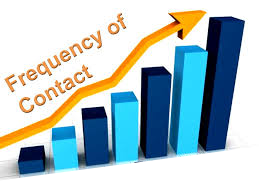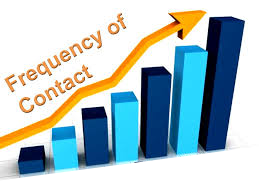
There is a bit of a controversy in major gifts about how often to ask a major donor for a gift.
Some say you should only ask once a year – this would be the “annual fund folks” who hold this opinion. Jeff has written about the need to kill the annual fund in his post on the subject. Read it to get our view on the annual fund concept.
Others hold a view that you really should only ask a couple to four times a year. Where they came up with that notion is beyond me.
Others would recommend that you leave all donors on the direct mail program no matter what is happening in the personal relationship. So, in this case, the solicitation, with appeals and newsletters, could run as high as 16-22 asks a year.
Still others say you really should never ask them – you should just continually present need and they will respond when they want.
Several months ago our colleague Jeff Brooks (Future Fundraising Now blog) gave us a link to The Agitator on the subject of frequency of asking. In his blog, entitled Dangerous Myth #1: Too Much Solicitation Causes Poor Retention, The Agitator dispels the notion that asking too much causes donors to get angry and stop giving to the organization. Granted, The Agitator is mostly talking, in my opinion, about direct marketing vs. personal solicitation. But his concerns and assertions apply to major gifts as well. More on that in a moment, but I want to finish looking at this dangerous myth first.
Jeff Brooks comments on The Agitator’s post and makes the following observations:
- There’s no proof that going to your donors a lot will chase them away. The myth arises from the fact that “too much solicitation” is one of the most common donor complaints.
- But this belief does not bear out in real life – in fact, more solicitation does not drive down retention. You are in far more danger from under-solicitation. That’s the quick way to slash revenue and lower retention.
- Rather than worrying about how often you communicate with donors and, as a result, lose revenue (and donors) by under-communicating, you should be worried about your relevance: If your fundraising is organizationally focused bragging, you are oversoliciting – even if you hardly ever communicate with your donors. If you aren’t thanking donors and reporting back to them on the impact of their giving, you are oversoliciting. If you aren’t speaking your donors’ language because you believe it’s your duty to teach them to speak yours, you are oversoliciting.
What Jeff Brooks is saying here is that not asking & not presenting need is a sure way to reduce revenue, help your donor give to someone else and hasten his or her dis-interest in your organization.
Let me tell you a story and show you how this discussion applies to major gifts.
Several weeks ago an MGO told me about a donor on his caseload who just gave $600,000 to another charity. This donor has been giving $5,000 a year to the MGO’s organization. The other charity is similar in emphasis and programs to the MGO’s organization. So the MGO was asking, “How come the donor gave them $600,000 is only giving us $5,000? We do the same things!”
Well, when I dug into the details of this situation I discovered that this MGO had a philosophy of only asking once a year, never bringing up other needs and being very careful to keep the number of touches with the donor low. So the quantity and quality of contact with this donor was very low.
The Agitator has this to say about this situation: “…having too few touches — just a single appeal as an extreme example — will prove detrimental to relationship strength, retention and value.” And this is exactly what happened in this situation.
While I don’t know the actual facts, I can imagine that the competing organization, the one that received the $600,000, was considerate and careful, but aggressive (or should I say animated and energetic?) about their relationship with the donor. That MGO, most likely, was continually telling the donor that her past giving was making a difference, was excitedly talking about what “more we can do together,” and was not shy about talking about need at a variety of times and in a variety of forms. In other words, there were a lot of touches and quite a few points at which the donor could engage and give, i.e., a combination of soft and hard asks.
So, specifically to the question, are you asking too often or not enough?
Jeff and I don’t think it’s about quantity of asks, although we do think you should create a number of encounters with the donor to present the need he is interested in supporting. And in that sense, I suppose, you should be creating and presenting more than one ask. But I am trying to walk a fine line here and avoid stating a number of asks that you should have. Instead, I want to persuade you to follow a principle. Here it is:
Treat a donor as a partner vs. a source of cash.
If you follow the principle of treating the donor as a partner it means there is continual dialogue and contact. There are questions and answers and discussion. There is disagreement. There are ideas shared. A partner is a real live, thinking, interacting human being who is, by agreement, on a journey with you – a journey that covers a lot of ground and moves through time. And the journey is not one event, or one ask. It is a continuum of touches and interactions.
And in this sense, the question of too much or too little asking is actually irrelevant since a focus on frequency of asks in this kind of relationship is not really appropriate or helpful. It is more about the quality of the relationship and whether you, as an MGO, are truly meeting the needs of the donor. That is what you need to focus on, not the number of asks.
Richard







0 Comments
Trackbacks/Pingbacks